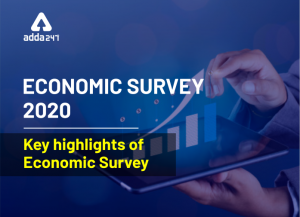
Finance Minister, Nirmala Sitharaman presented Economic Survey 2019-20 in the Parliament today (31 January 2020). This year’s Economic survey is being prepared by the Chief Economic Advisor, Krishnamurthy V Subramanian.
The theme for the Economic Survey 2020 is Theme: Wealth Creation, Promotion of pro-business policies, strengthening of trust in the economy.
The report will be followed by a press conference where the Chief Economic Advisor and his team will discuss the economic roadmap for the next fiscal. It is a review of the developments in the country’s economy over the previous year. It presents a summary of the performance of the government’s major development programmes undertaken during that period. It also details the main policy initiatives of the government.
Here are the key highlights from the Economic Survey 2019-20:
- Forecasts India’s economic growth at between 6 to 6.5% for the fiscal year starting April.
- ‘Assemble in India for the world’ which will create jobs.
- India’s GDP growth moderated to 4.8 % in H1 of 2019-20, amidst a weak environment for global manufacturing, trade and demand.
- Current Account Deficit (CAD) narrowed to 1.5 % of GDP in H1 of 2019-20 from 2.1 % in 2018-19.
- Announcing the National Infrastructure Pipeline 2019-2025.
- Easing of credit, particularly for the stressed real estate and NBFC sectors.
- The Survey noted, the two Schemes, Pradhan Mantri Awaas Yojana- Gramin (PMAY-G) and Pradhan Mantri Awaas Yojana- Urban (PMAY-U), seek to achieve the target of housing for all by 2022. Under PMAY-G, the number of houses completed in a year increased by more than four times, from 11.95 lakh in 2014-15 to 47.33 lakh in 2018-19.
- Speeding up the insolvency resolution process under Insolvency and Bankruptcy Code (IBC).
- Revenue Receipts registered a higher growth during the first eight months of 2019-20, compared to the same period last year, led by considerable growth in Non-Tax revenue.
- Gross GST monthly collections have crossed the mark of Rs. 1 lakh crore for a total of five times during 2019-20 (up to December 2019).
- Measures to ease the implementation of GST.
- Fiscal deficit of states within the targets set out by the Fiscal Responsibility and Budget Management Act (FRBM Act).
- The survey notes that the General Government (Centre plus states) has been on the path of fiscal consolidation.
- India’s BoP position improved from US$ 412.9 bn of forex reserves in end-March, 2019 to US$ 433.7 bn in end September 2019.
- Current account deficit (CAD) narrowed from 2.1% in 2018-19 to 1.5% of GDP in H1 of 2019-20.
- Foreign reserves stood at US$ 461.2 bn as on 10th January 2020.
- India’s top five trading partners continue to be USA, China, UAE, Saudi Arabia and Hong Kong.
- India’s imports continue to be the largest from China, followed by USA, UAE and Saudi Arabia.
- Merchandise imports to GDP ratio declined for India, entailing a net positive impact on BoP.
- Under trade facilitation, India improved its ranking from 143 in 2016 to 68 in 2019 under the indicator, “Trading across Borders”, monitored by World Bank in its Ease of Doing Business Report.
- Currently estimated to be around US$ 160 billion. Expected to touch US$ 215 billion by 2020.
- Net FDI inflows continued to be buoyant in 2019-20 attracting US$ 24.4 bn in the first eight months, higher than the corresponding period of 2018-19.
- Net FPI in the first eight months of 2019-20 stood at US$ 12.6 bn.
- Remained accommodative in 2019-20. Repo rate was cut by 110 basis points in four consecutive MPC meetings in the financial year due to slower growth and lower inflation.
- Increased slightly for the Non-Banking Financial Corporations (NBFCs) from 6.1% in March 2019 to 6.3% in September 2019.
- Bank Credit growth (YoY) moderated from 12.9% in April 2019 to 7.1% as on December 20, 2019.
- Consumer Price Index (CPI) inflation increased from 3.7 per cent in 2018-19 (April to December 2018) to 4.1 per cent in 2019-20 (April to December 2019).
- WPI inflation fell from 4.7 per cent in 2018-19 (April to December 2018) to 1.5 per cent during 2019-20 (April to December 2019).
- India moving forward on the path of SDG implementation through well-designed initiatives.
- India hosted COP-14 to UNCCD which adopted the Delhi Declaration: Investing in Land and Unlocking Opportunities. Increasing and has reached 80.73 million hectares. 24.56 % of the geographical area of the country.
- ‘Enabler’ by institutionalizing 30 Fellowships from the Member countries.
- ‘Facilitator’ by getting the lines of credit worth US$ 2 Billion from EXIM Bank of India and 1.5 Billion from AfD, France.
- ‘Incubator’ by nurturing initiatives like the Solar Risk Mitigation Initiative.
- ‘Accelerator’ by developing tools to aggregate demand for 1000 MW solar and 2.7 lakh solar water pumps.
- The share of agriculture and allied sectors in the total Gross Value Added (GVA) of the country has been continuously declining on account of relatively higher growth performance of non-agricultural sectors, a natural outcome of the development process.
- GVA at Basic Prices for 2019-20 from ‘Agriculture, Forestry and Fishing’ sector is estimated to grow by 2.8 %.
- Food Processing Industries sector has been growing:
- Average Annual Growth Rate (AAGR) of around 5.06 %
- The industrial sector as per the Index of Industrial Production (IIP) registered a growth of 0.6 per cent in 2019-20 (April-November) as compared to 5.0 % during 2018-19 (April-November).
- The installed capacity of power generation has increased to 3, 64,960 MW as on October 31, 2019, from 3, 56,100 MW as on March 31, 2019.
- The Task Force on National Infrastructure Pipeline released on 31.12.2019 has projected total infrastructure investment of Rs. 102 lakh crore during the period FY 2020 to 2025 in India.
- About 55 % of the total size of the economy and Gross value added (GVA) growth.
- Two-thirds of the total FDI inflows into India. About 38% of the total exports.
- More than 50% of GVA in 15 out of the 33 states and UTs.
- FDI into the services sector has witnessed a recovery in early 2019-20.
- The expenditure on social services (health, education and others) by the Centre and States as a proportion of GDP increased from 6.2 % in 2014-15 to 7.7 % in 2019-20 (BE).
- Gross Enrolment Ratio at secondary, higher secondary and higher education level needs to be improved.
- Mission Indradhanush has vaccinated 3.39 crore children and 87.18 lakh pregnant women of 680 districts across the country.
- Around 60 % of productive age (15-59) group engaged in full-time domestic duties.
- A 10 Year Rural Sanitation Strategy (2019-2029) launched to focus on sustaining the sanitation behaviour change and increasing access to solid and liquid waste management.
- Eliminate policies that undermine markets through government intervention even where it is not necessary to enable trade for job creation efficiently scale up the banking sector to be proportionate to the size of the Indian economy.
- The exponential rise in India’s GDP and GDP per capita post-liberalisation coincides with wealth generation.
- Survey shows that the liberalized sectors grew significantly faster than the closed ones.
- Introducing the idea of trust as a public good, which gets enhanced with greater use.
- Entrepreneurship as a strategy to fuel productivity growth and wealth creation.
- India ranks 3rd in a number of new firms created, as per the World Bank.
- 12.2 % cumulative annual growth rate of new firms in the formal sector during 2014-18, compared to 3.8 % during 2006-2014.
- A 10 % increase in registration of new firms in a district yields a 1.8 % increase in Gross Domestic District Product (GDDP).
- Literacy and education in a district foster local entrepreneurship significantly.
- The impact is most pronounced when literacy is above 70 per cent.
- The new firm formation is the lowest in eastern India with the lowest literacy rate (59.6 % as per 2011 Census).
- Promoting a ‘pro-business’ policy that unleashes the power of competitive markets to generate wealth.
- The “Startup India” campaign of the Government of India recognizes entrepreneurship as an increasingly important strategy to fuel productivity growth and wealth creation in India.
- The frequent and unpredictable imposition of blanket stock limits on commodities under the Essential Commodities Act (ECA) neither brings down prices nor reduces price volatility. Around 76000 raids under ECA were conducted during 2019.
- The regulation of prices of drugs through the Drug Price Control Orders DPCO 2013, has led to an increase in the price of a regulated pharmaceutical drug vis-à-vis that of a similar drug whose price is not regulated.
- Government policies in the foodgrain markets have led to the emergence of Government as the largest procurer and hoarder of foodgrains.
- Analysis of debt waivers given by States/Centre shows that full waiver beneficiaries consume less, save less, invest less and are less productive after the waiver when compared to the partial beneficiaries.
- “Assemble in India for the world” into Make in India, India can create 4 crore well-paid jobs by 2025 and 8 crores by 2030.
- Exports of network products, which is expected to equal $7 trillion worldwide in 2025, can contribute a quarter of the increase in value-added for the $5 trillion economies by 2025.
- India has risen significantly in the World Bank’s Doing Business rankings in recent years, but there are categories where it lags behind – Starting a Business, Registering Property, Paying Taxes and Enforcing Contracts.
- In 2019, India completed the 50th anniversary of bank nationalization. Accomplishments of lakhs of Public Sector Banks (PSBs) employees cherished and an objective assessment of PSBs suggested by the Survey.
- India has only one bank in the global top 100: same as countries that are a fraction of its size: Finland (about 1/11th), Denmark (1/8th), etc.
- The survey investigates the key drivers of Rollover Risk of the shadow banking system in India in light of the current liquidity crunch in the sector.
- Raise its export market share to about 3.5 % by 2025 and 6 % by 2030. Create 4 crore well-paid jobs by 2025 and 8 crores by 2030.
- Exports of network products can provide one-quarter of the increase in value-added required for making India a $5 trillion economy by 2025.
- A jump of 79 positions to 63 in 2019 from 142 in 2014 in World Bank’s Doing Business rankings.
- The turnaround time of ships in India has almost halved to 2.48 days in 2018-19 from 4.67 days in 2010-11.
- The survey examines the realized efficiency gains from privatization in the Indian context and bolsters the case for aggressive disinvestment of CPSEs. Strategic disinvestment of Government’s shareholding of 53.29 per cent in BPCL led to an increase of around Rs. 33,000 crores in national wealth.
- The survey examines the realized efficiency gains from privatization in the Indian context and bolsters the case for aggressive disinvestment of CPSEs.
- Models that incorrectly over-estimate GDP growth by 2.7 % for India post-2011 also misestimate GDP growth over the same period for 51 out of 95 countries in the sample.
- An attempt to quantify what a common person pays for a Thali across India. A shift in the dynamics of Thali prices since 2015-16.
- Rationalisation of Government Intervention to Boost Economic Freedom & Wealth Creation required.



 Weekly One Liners 15th to 21st of Decemb...
Weekly One Liners 15th to 21st of Decemb...
 World Basketball Day 2025 Celebrates Bas...
World Basketball Day 2025 Celebrates Bas...
 UN Celebrates Second World Meditation Da...
UN Celebrates Second World Meditation Da...







